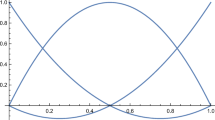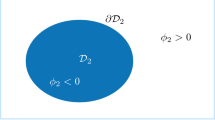Abstract
The p-norm often used in stress constrained topology optimisation supposedly mimics a delta function and it is thus characterised by a small length scale and ideally one would also prefer to have the solid-void transition occur over a small length scale, since the material in this transition does not have a clear physical interpretation. We propose to resolve these small length scales using anisotropic mesh adaptation. We use the method of moving asymptotes with interpolation of sensitivities, asymptotes and design variables between iterations. We demonstrate this combination for the portal and L-bracket problems with p=10, and we are able to investigate mesh dependence. Finally, we suggest relaxing the L-bracket problem statement by introducing a rounded corner.










Similar content being viewed by others
Notes
Preliminary results related to this work was presented at FEniCS 14 in Paris, June 2014, at the International Meshing Roundtable 23 in London, October 2014 and at the eleventh World Congress of Structural and Multidisciplinary Optimisation in Sydney, June 2015.
except for the one case where an optimisation of the rounded L-bracket problem fails to recover from an infeasible design.
Using an Intel(R) Core(TM) i7 870 @ 2.93GHz.
References
Aage N, Poulsen TH, Gersborg-Hansen A, Sigmund O (2008) Topology optimization of large scale stokes flow problems. Struct Multidiscip Optim 35(2):175–180
Aage N, Andreassen E, Lazarov BS (2014) Topology optimization using petsc. Struct Multidiscip Optim
Adrien L (2014) Metric-orthogonal anisotropic mesh generation. Procedia Eng 82:403–415
Agouzal A, Lipnikov K, Vassilevski Y (1999) Adaptive generation of quasi-optimal tetrahedral meshes. East West J Numer Math 7(4):223–244
Amstutz S, Novotny AA (2010) Topological optimization of structures subject to von mises stress constraints. Struct Multidiscip Optim 41(3):407–420
Bendsoe MP, Sigmund O (2003) Topology optimization: theory, methods and applications. Springer
Borrvall T, Petersson J (2001) Large-scale topology optimization in 3d using parallel computing. Comput Methods Appl Mech Eng 190(46):6201–6229
Bruggi M, Duysinx P (2012) Topology optimization for minimum weight with compliance and stress constraints. Struct Multidiscip Optim 46(3):369–384
Chen L, Sun P, Xu J (2007) Optimal anisotropic meshes for minimizing interpolation errors in l p-norm. Math Comput 76(257):179–204
Cheng GD, Guo X (1997) ε-relaxed approach in structural topology optimization. Struct Optim 13(4):258–266
Christiansen AN, Bærentzen JA, Nobel-Jørgensen M, Aage N, Sigmund O (2015) Combined shape and topology optimization of 3d structures. Comput Graph 46:25–35
Dompierre J, Vallet M-G, Bourgault Y, Fortin M, Habashi WG (2002) Anisotropic mesh adaptation: towards user-independent, mesh-independent and solver-independent cfd. part iii. unstructured meshes. Int J Numer Methods Fluids 39(8):675–702
Duysinx P, Sigmund O (1998) New developments in handling stress constraints in optimal material distribution. In: Proceedings of the 7th AIAA/USAF/NASAISSMO Symp on Multidisciplinary Analysis and Optimization, vol 1, pp 1501–1509
Farrell PE (2009) Galerkin projection of discrete fields via supermesh construction. PhD thesis, Imperial College London
Farrell PE, Ham DA, Funke SW, Rognes ME (2013) Automated derivation of the adjoint of high-level transient finite element programs. SIAM J Sci Comput 35(4):C369–C393
Guo X, Zhang WS, Wang MY, Wei P (2011) Stress-related topology optimization via level set approach. Comput Methods Appl Mech Eng 200(47):3439–3452
Habashi WG, Dompierre J, Bourgault Y, Ait-Ali-Yahia D, Fortin M, Vallet M-G (2000) Anisotropic mesh adaptation: Towards user-independent, mesh-independent and solver-independent cfd. part i: General principles. Int J Numer Methods Fluids 32(6):725–44
Holmberg E, Bo T, Klarbring A (2013) Stress constrained topology optimization. Struct Multidiscip Optim 48(1):33–47
Jensen KE, Gorman G (2015) Details of tetrahedral anisotropic mesh adaptation. Comput Phys Commun
Lazarov BS, Sigmund O (2011) Filters in topology optimization based on helmholtz-type differential equations. Int J Numer Methods Eng 86(6):765–781
Le C, Norato J, Bruns T, Ha C, Tortorelli D (2010) Stress-based topology optimization for continua. Struct Multidiscip Optim 41(4):605–620
Alnaes M., Blechta J, Hake J, Johansson A, Kehlet B, Logg A, Richardson C, Ring J, Rognes ME, Wells GN (2015) The FEniCS Project Version 1.5. Arch Numer Softw 3(100)
Loseille A, Alauzet F (2011) Continuous mesh framework part i: well-posed continuous interpolation error. SIAM J Numer Anal 49(1):38–60
Loseille A, Dervieux A, Alauzet F (2010) Fully anisotropic goal-oriented mesh adaptation for 3d steady euler equations. J Comput Phys 229(8):2866–2897
Pain CC, Umpleby AP, De Oliveira CRE, Goddard AJH (2001) Tetrahedral mesh optimisation and adaptivity for steady-state and transient finite element calculations. Comput Methods Appl Mech Eng 190 (29):3771–3796
Qi X, Shi T, Liu S, Wang MY (2012) A level set solution to the stress-based structural shape and topology optimization. Comput Struct 90:55–64
Rokos G, Gorman GJ, Southern J, Kelly PHJ (2013) A thread-parallel algorithm for anisotropic mesh adaptation. arXiv:1308.2480
Sigmund O, Maute K (2012) Sensitivity filtering from a continuum mechanics perspective. Struct Multidiscip Optim 46(4):471–475
Suresh K, Takalloozadeh M (2013) Stress-constrained topology optimization: a topological level-set approach. Struct Multidiscip Optim 48(2):295–309
Svanberg K (1987) The method of moving asymptotesa new method for structural optimization. Int J Numer Methods Eng 24(2):359– 373
Wallin M, Ristinmaa M, Askfelt H (2012) Optimal topologies derived from a phase-field method. Struct Multidiscip Optim 45(2):171–183
Wang F, Lazarov BS, Sigmund O (2011) On projection methods, convergence and robust formulations in topology optimization. Struct Multidiscip Optim 43(6):767–784
Zhang WS, Guo X, Wang MY, Wei P (2013) Optimal topology design of continuum structures with stress concentration alleviation via level set method. Int J Numer Methods Eng 93(9):942–59
Acknowledgments
This work is supported by the Villum Foundation.
Author information
Authors and Affiliations
Corresponding author
Rights and permissions
About this article
Cite this article
Jensen, K.E. Solving stress and compliance constrained volume minimization using anisotropic mesh adaptation, the method of moving asymptotes and a global p-norm. Struct Multidisc Optim 54, 831–841 (2016). https://doi.org/10.1007/s00158-016-1439-9
Received:
Revised:
Accepted:
Published:
Issue Date:
DOI: https://doi.org/10.1007/s00158-016-1439-9




